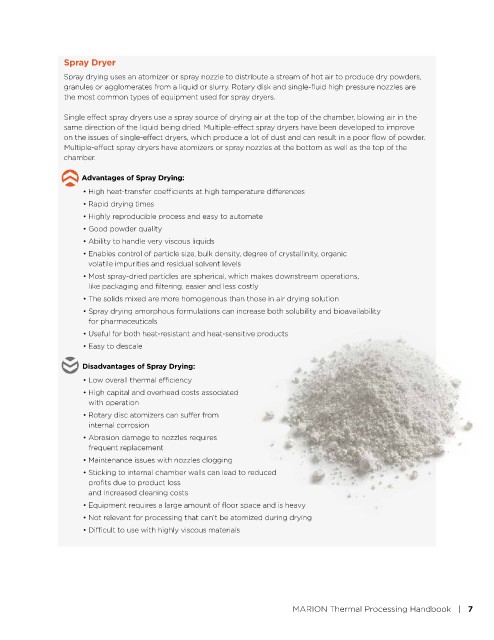Page 2709 - Flipbook_SolidDesignSoutheast2020
P. 2709
Spray Dryer
Spray drying uses an atomizer or spray nozzle to distribute a stream of hot air to produce dry powders,
granules or agglomerates from a liquid or slurry. Rotary disk and single-fluid high pressure nozzles are
the most common types of equipment used for spray dryers.
Single effect spray dryers use a spray source of drying air at the top of the chamber, blowing air in the
same direction of the liquid being dried. Multiple-effect spray dryers have been developed to improve
on the issues of single-effect dryers, which produce a lot of dust and can result in a poor flow of powder.
Multiple-effect spray dryers have atomizers or spray nozzles at the bottom as well as the top of the
chamber.
Advantages of Spray Drying:
• High heat-transfer coefficients at high temperature differences
• Rapid drying times
• Highly reproducible process and easy to automate
• Good powder quality
• Ability to handle very viscous liquids
• Enables control of particle size, bulk density, degree of crystallinity, organic
volatile impurities and residual solvent levels
• Most spray-dried particles are spherical, which makes downstream operations,
like packaging and filtering, easier and less costly
• The solids mixed are more homogenous than those in air drying solution
• Spray drying amorphous formulations can increase both solubility and bioavailability
for pharmaceuticals
• Useful for both heat-resistant and heat-sensitive products
• Easy to descale
Disadvantages of Spray Drying:
• Low overall thermal efficiency
• High capital and overhead costs associated
with operation
• Rotary disc atomizers can suffer from
internal corrosion
• Abrasion damage to nozzles requires
frequent replacement
• Maintenance issues with nozzles clogging
• Sticking to internal chamber walls can lead to reduced
profits due to product loss
and increased cleaning costs
• Equipment requires a large amount of floor space and is heavy
• Not relevant for processing that can’t be atomized during drying
• Difficult to use with highly viscous materials
MARION Thermal Processing Handbook | 7

